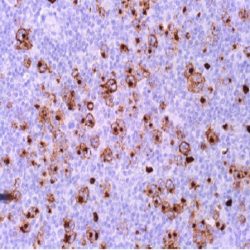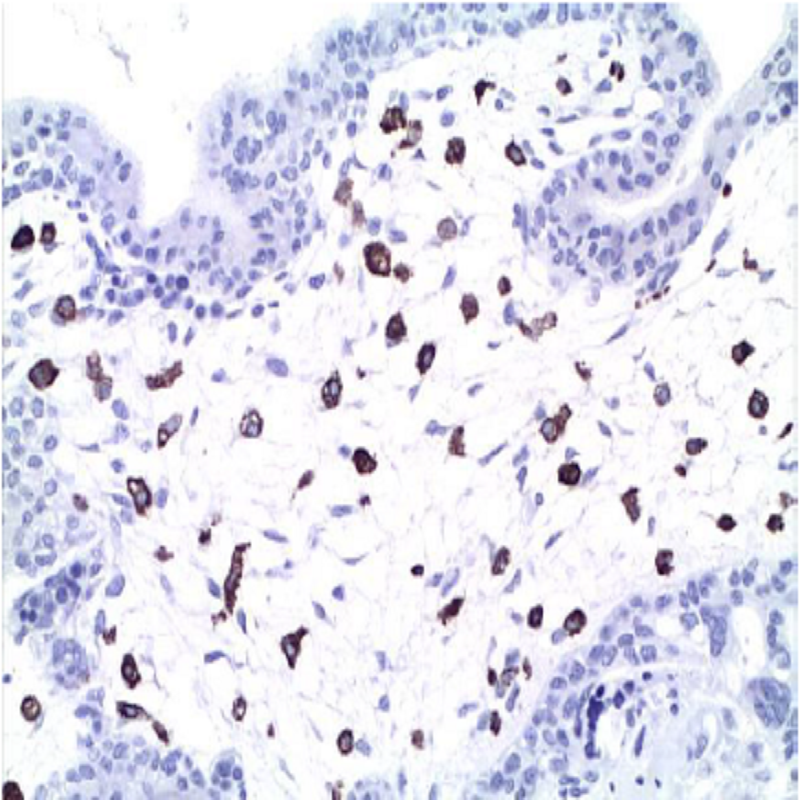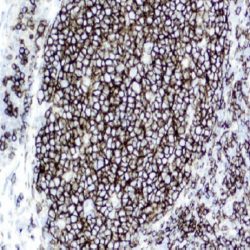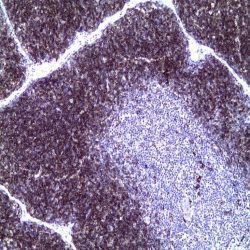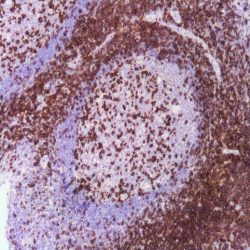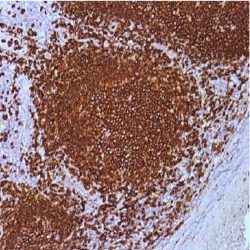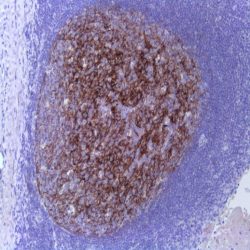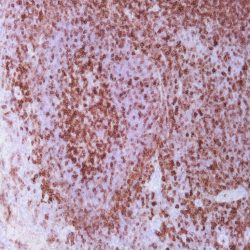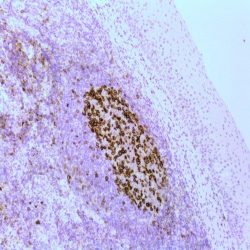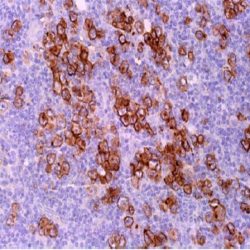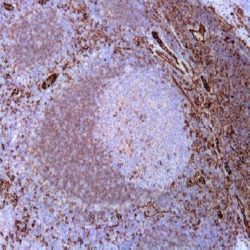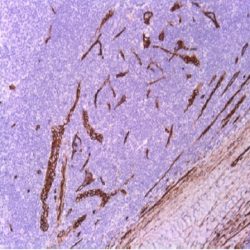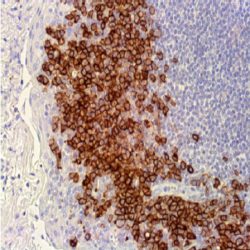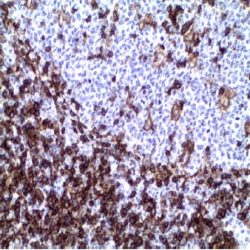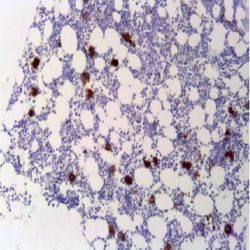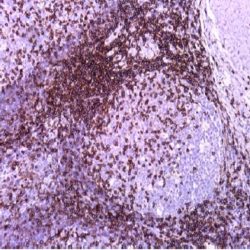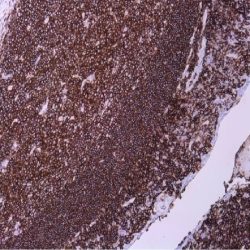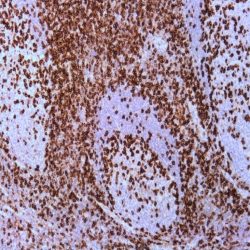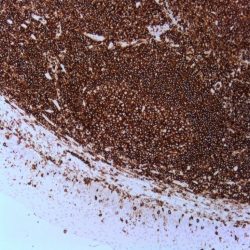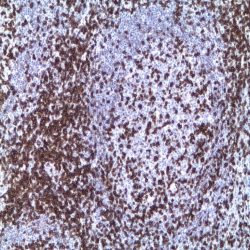Category: monoclonal
Showing 101–120 of 477 results
فیلتر ها-
آنتی بادیهای ایمونوهیستوشیمی
آنتی بادی CD15 (MMA)
Rated 0 out of 5Name: CD15 Antibody (Clone MMA)
Description and aplications: This antibody reacts against the human antigen CD15 (fucosyltransferase 4) also known as Lewis X (Lex); 3-fucosyl-Nacetyllactosamine [3-FL]; X hapten; specific embryonic antigen-1 to step [SSEA-1]; lacto-N-fucopentaose III
[LNFP III]. This antibody is expressed in normal myelomonocytic cells (90% of human neutrophil granulocytes in peripheral blood and lymphoid and 30% – 60% of circulating monocytes), not being present in normal lymphocytes. CD15 is consistently expressed by the
epithelial cells of renal tubules, gastric glandular epithelium, tonsil and esophageal squamous epithelium, ductal epithelium of salivary glands, pancreas and mammary ducts, thymus Hassall corpuscles, gray and white matter and in endocrine cells of the adrenal cortex and anterior pituitary. In neoplasms, CD15 antigen is expressed by the Reed- Sternberg cells of classic Hodgkin lymphoma (membrane pattern and / or Golgi area), in some leukemias (acute and chronic myeloid leukemia (> 50%), acute myelogenous leukemia (> 95% of chronic phase and> 50% blast phase), and in carcinomas derived from organs whose cells are positive for CD15, including adenocarcinomas of kidney, digestive tract, squamous cell carcinomas. The CD15 may be useful in confirming the diagnosis of Hodgkin’s disease and the differential diagnosis of mesothelioma (usually negative) and lung adenocarcinoma (usually positive).Composition: anti-human CD15 mouse monoclonal antibody purified from ascites fluid by Protein A chromatography. Prepared in 10mM PBS, pH 7.4, with 0.2% BSA and 0.09% sodium azide.
-
آنتی بادیهای ایمونوهیستوشیمی
آنتی بادی CD163 (EP324)
Rated 0 out of 5Name: CD163 Antibody (Clone EP324)
Description and aplications: CD163 was recently identified as an acute phase-regulated transmembrane protein whose function is to mediate the endocytosis of haptoglobin-hemoglobin complexes. This receptor is expressed on the surface of monocytes (low expression) and tissue macrophages [also known as histiocytes] (high expression). It is a member of the cysteine-rich scavenger receptor superfamily, encoded by a gene localized on human chromosome 12p13.3. Solubilized in plasma, CD163 functions as an anti-inflammatory signal and has many roles in disease processes that range from autoimmune conditions such as rheumatoid arthritis to atherosclerosis. Previous work has shown that the CD163 gene can be regulated by glucocorticoids, IL-10, and other inflammatory modulators, and is highly expressed in inflamed tissues, consistent with its role in the resolution of inflammation.
Staining for CD163 has been helpful in distinguishing synovial macrophages from synovial intimal fibroblasts in the setting of rheumatoid arthritis,where its specificity for macrophages was found to be superior to that of CD68, which does not discriminate between these cell types. Increased levels of CD163 were also detected in patients with microbial infections and myelomonocytic leukemias by an enzyme-linked immunosorbent assay. Flow cytometry studies have confirmed that CD163 expression is limited to leukemias with monocytic differentiation. Another recent study showed that all 5 cases of synovial-type giant cell tumors of the vertebral column stained for CD163.Composition: anti-human CD163 mouse monoclonal antibody obtained from supernatant. Prepared in 10mM PBS, pH 7.4, with 0.2% BSA and 0.09% sodium azide.
-
آنتی بادیهای ایمونوهیستوشیمی
آنتی بادی CD19 (SP110)
Rated 0 out of 5Name: CD19 Antibody (Clone SP110)
Description and aplications: This antibody recognizes the CD19, a surface glycoprotein of 95 kD which is present in both malignant and normal B cells which was always been considered as the most reliable surface marker of this cell line, within all range of stages of maturation. In the normal lymphoid tissue, the CD19 staining appears in germinal centers (follicular dendritic cells and B cells) in the mantle zone and as scattered cells within the interfollicular areas with overlapping patterns of immunostaining with CD20 and CD22 cells. However, in contrast to CD20, CD19 is also expressed on pre-B cells. CD19 was detected by flow cytometry in extramedullary plasma cells isolated from human tissue. CD19 positivity appears in the vast majority of B cell neoplasms while the plasma cell neoplasms are always negative. No CD19 stain was detected in Reed- Sternberg cells of Hodgkin’s disease.
Composition: anti-CD19 mouse monoclonal antibody obtained from supernatant culture and prediluted in a tris buffered solution pH 7.4 containing 0.375mM sodium azide solution as bacteriostatic and bactericidal.
-
آنتی بادیهای ایمونوهیستوشیمی
آنتی بادی CD1a (EP80)
Rated 0 out of 5Name : Rabbit anti-human CD1a Monoclonal Antibody clone EP80
Description and applications: Cluster of Differentiation 1a (CD1a) is part of a family of major histocompatibility complex (MHC) antigen-like glycoproteins that associate with beta-2- microglobulin. CD1a binds self and non-self lipid and glycolipid antigens, presenting them to T-cell receptors on natural killer T-cells. CD1a antibody labels cortical thymocytes, Langerhans’ cells and dendritic cells. It has been used to identify Langerhans’ cell histiocytosis and precursor T lymphoblastic lymphoma/leukemia.
Composition: Anti-human CD1a rabbit monoclonal antibody purified from serum and prepared in 10mM PBS, pH 7.4, with 0.2% BSA and 0.09% sodium azide
Intended use: Immunohistochemistry (IHC) on paraffin embedded tissues. Not tested on frozen tissues or Western-Blotting
Immunogen: A synthetic peptide corresponding to residues in human CD1a protein.
-
آنتی بادیهای ایمونوهیستوشیمی
آنتی بادی CD2 (EP222)
Rated 0 out of 5Name: CD2 Antibody Clone EP222
Description and applications: T-cell surface antigen CD2 (CD2) is a T-cell specific surface glycoprotein that is critically important for mediating adherence of T cells to antigen-presenting cells or target cells. It interacts with lymphocyte functionassociated antigen (LFA-3) and CD48/BCM1 to mediate adhesion between T-cells and other cell types. CD2 is involved in triggering T-cells, and the cytoplasmic domain is involved in signaling. CD2 is a pan T-cell marker. CD2 antibody labels T-cell, thymocytes and natural killer (NK) cells. CD2 is absent in a small subset of T cells. CD2 antibody is useful for identification of precursor and mature T-cell lymphomas. Aberrant loss of CD2 in T-cell lymphomas may helpful to distinguish them from reactive T-cell proliferations.
Composition: Anti-human CD2 rabbit monoclonal antibody purified from serum and prepared in 10mM PBS, pH 7.4, with 0.2% BSA and 0.09% sodium azide.
Immunogen:human CD2 recombinant protein.
-
آنتی بادیهای ایمونوهیستوشیمی
آنتی بادی CD20 (L26)
Rated 0 out of 5Name: Mouse Anti-CD20 Monoclonal Antibody clone L26
Description and aplications: CD20 is a non-Ig differentiation antigen of B cells and the expression of CD20 is restricted to normal and neoplastic B cells, being absent from all other leukocytes and tissues. It acts as calcium channel involved in B cell activation and cell cycle progression. The antibody is useful for identifying B cell lymphoid malignancies, whether non-Hodgkin lymphoma, acute or chronic B lymphocytic leukemias and hairy cell leukemia. Also, the anti-CD20 antibody stains the tumor cells of Hodgkin’s disease nodular lymphocytepredominant subtype and occasionally, the Reed- Sternberg cells of other histologic variants of classic Hodgkin’s disease.
Composition: anti-CD20 mouse monoclonal antibody obtained from supernatant culture and prediluted in a tris buffered solution pH 7.4 containing 0.375mM sodium azide solution as bacteriostatic and bactericidal.
Immunogen: Human tonsil B cells.
-
آنتی بادیهای ایمونوهیستوشیمی
آنتی بادی CD21 (2G9)
Rated 0 out of 5Name: CD21 Antibody Clone 2G9
Description and applications: The CD21 or CR2 antigen is a 145 kD glycoprotein of molecular weight, which constitutes one of the
membrane molecules involved in the transduction of growth signals into the B cells. Also acts as a receptor for the Epstein Barr virus. This antibody also reacts with a leukocyte membrane epitope (CR2), with molecular weights of 95, 72, 50, 32 and 28 kD. The 28 and 72 kD molecular weight fragments of CR2 constitute the point of attachment of C3d. CD21 antigen is an antigen that is expressed in mature B cells. The antigen is present with a high density in follicular dendritic cells (CFD) of B zones of lymphoid tissue. CD21 moderately stains B cells and strongly follicular dendritic cells in frozen tissue sections, while staining of B cells is reduced or non existent in the paraffin embedded sections. Immunostaining of CFDsin paraffin-embedded sections is as strong as that of frozen tissue sections. CD21 immunohistological analysis of CFD of non- Hodgkin’s lymphomas in paraffin embedded sections reveals the generally dense and highly defined nodular network of CFD in follicular lymphomas and a diffuse, disorganised network in some types of diffuse lymphomas. B-cell precursor lymphomas (lymphoblastic lymphomas), Burkitt’s lymphomas, plasmacytomas, and hairy cell leukemias are
constantly lacking a CFD. In non-Hodgkin’s lymphomas of T cell origin, CFDs are mainly restricted to peripheral T-cell lymphomas of the
angioinmunoblastic type and some cases of pleomorphic lymphomas. T-cell lymphoblastic lymphomas, T-CLL and mycosis fungoides do not have a CFD network. The only category of Hodgkin’s disease that has a CFD-like network is the nodular lymphocyte-predominant
form.Composition: Anti-human CD21 mouse monoclonal antibody purified from serum and prepared in 10mM PBS, pH 7.4, with 0.2% BSA and 0.09% sodium azide.
Immunogen: Recombinant human CD21.
-
آنتی بادیهای ایمونوهیستوشیمی
آنتی بادی CD27 (EPR8569)
Rated 0 out of 5Name: CD27 Antibody Clone EPR8569
Description and applications: CD27 is a glycosylated, type I transmembrane protein with a molecular mass of 50-55 kDa that belongs to the TNF receptor superfamily (TNFRSF7), of which it is its seventh member. This protein is also known as T cell activation antigen, S152 protein and T14 protein. It is encoded by a gene located in the chromosomal region 12p13.31. As a member of the tumour necrosis factor (TNF) receptor family, CD27 plays an important role in cell growth and differentiation as well as in apoptosis regulation. In the former case, CD27 binds to CD70, its ligand, and plays an important role in costimulation of T cell activation and regulation of B cell differentiation and proliferation and immunoglobulin synthesis. The cytoplasmic domains of CD27 have also been shown to interact with TRAF2 and TRAF5 to promote activation of NF-kappa B and SAPK/JNK. Its role inapoptosis is linked to its ability to bind to the proapoptotic SIVA protein; thus, CD27 plays an important role in inducing this cell death process. CD27 is expressed in medullary thymocytes, virtually all mature T cells, memory B cells, NK cells, and a fraction of normal plasma cells but not in virgin B cells or effector T cells. In patients diagnosed with acute lymphoblastic leukaemia (ALL), overexpression of CD27 is associated with a more favourable prognosis and an increased anti-leukaemic immune response by the organism. Immunohistochemical techniques have confirmed the expression of the CD27 antigen in isolated cases of mantle cell lymphoma, Burkitt lymphoma, marginal zone lymphoma, and plasmacytoma. In cases of multiple myeloma, apparently the expression of CD27 has predictive value for patient survival, with an overall three-year survival rate of 92% in positive cases compared to 50% in negative cases. CD27 negativity in cases of hairy-cell leukaemia diagnosed in the spleen has been suggested as a useful tool in the differential diagnosis with other types of B cell leukaemia.
Composition: Anti-human CD27 mouse monoclonal antibody purified from serum and prepared in 10mM PBS, pH 7.4, with 0.2% BSA and 0.09% sodium azide.
Immunogen:Human recombinant protein similar to CD27.
-
آنتی بادیهای ایمونوهیستوشیمی
آنتی بادی CD278 (SP98)
Rated 0 out of 5Name: CD278 Antibody Clone SP98
Description and applications: CD278 belongs to the CD28 and CTLA-4 cell-surface receptor family and is highly expressed in activated T cells. It is essential both for efficient interaction between T and B cells and for normal antibody responses to T cell dependent antigens. It enhances all basic T cell responses to a foreign antigen, namely proliferation, secretion of lymphokines, up-regulation of molecules that mediate cell-cell interaction, and effective help for antibody secretion by B cells.
Composition: Anti-human CD278 rabbit monoclonal antibody purified from serum and prepared in 10mM PBS, pH 7.4, with 0.2% BSA and 0.09% sodium azide.
Immunogen: Synthetic peptide corresponding to the C-terminus of human CD278.
-
آنتی بادیهای ایمونوهیستوشیمی
آنتی بادی CD30 (Ber-H2)
Rated 0 out of 5Name: CD30 Antibody Clone Ber-H2
Description and aplications: The CD30 antigen (also called Ki-1) is a single chain glycoprotein that belongs to the family of for tumor necrosis receptors factors (TNF)
and acts as a type 1 transmembrane receptor. The gene encoding CD30 has been mapped to chromosome 1p36. The CD30 glycoprotein is synthesized as a 90 kDa precursor that is transformed into the Golgi complex in a mature 105/120 kDa phosphorylated glycoprotein that binds to the cell membrane. In normal tissues CD30 expression is restricted to some immunoblasts (both B and T) located around lymphoid follicles of antigenically stimulated lymphoid tissue, acinar cells of the pancreas and during pregnancy, by some decidual cells. In neoplasms, the CD30 antigen is expressed in anaplastic tumors, such as the mono- bi- and multinucleated cells of Hodgkin’s disease cells and thevast majority of anaplastic large cell lymphoma, a third of which lack the CD45 immunostaining. The CD30 antigen is also expressed in some non-hematopoietic malignancies such as embryonal carcinomas and rarely in poorly differentiated tumors of epithelial origin or melanocytes. For this reason and for in vitro diagnosis, the CD30 antibody should be used as part of an ample panel of antibodies that rule out the possibility of nonlymphoid origin for positive tumors.Composition: anti-human CD30 mouse monoclonal antibody purified from ascites fluid by Protein A chromatography. Prepared in 10mM PBS, pH 7.4, with
0.2% BSA and 0.09% sodium azide.Immunogen: Co cells.
-
آنتی بادیهای ایمونوهیستوشیمی
آنتی بادی CD31/PECAM-1 (JC/70A)
Rated 0 out of 5Name: CD31 Antibody Clone JC/70A
Description and aplications: CD31 is a glycoprotein expressed on endothelial cells and in platelets. It is known to be involved in cell signaling and cell adhesion. The anti-CD31 antibody is useful for the identification of benign and malignant vascular tumors. Other lesions like histiocytosis X, sinus histiocytosis with massive lymphadenopathy or Rosai-Dorfman disease, plasmacytoma and multiple myeloma are also frequently positive to CD31.
Composition: anti-human CD31 mouse monoclonal antibody purified from culture supernatant. Prepared in 10mM PBS, pH 7.4, with 0.2% BSA and 0.09% sodium azide.
Immunogen: Membrane preparation of a spleen from a patient with hairy cell leukemia.
-
آنتی بادیهای ایمونوهیستوشیمی
آنتی بادی CD34 (QB-End/10)
Rated 0 out of 5Name:CD34 Antibody clone QBEnd/10
Description and aplications: The QBEnd10 antibody is a class II monoclonal antibody that recognizes an epitope of CD34 that is resistant to neuraminidase and sensitive to glycoprotease and chymopapain. CD34, a single chain transmembrane glycoprotein, is detected in bone marrow precursors, including normal lymphoid precursors or hematogonias where it may act as lectins ligand of these cells with the bone marrow stroma. CD34 expression disappears from the surface of all haematological series during maturation. Megakaryocytes may show varying positivity for CD34. This antibody shows reactivity with most endothelial
cells, expressed on the luminal surface and interdigitating membrane processes between endothelial cells, but is absent in large venous and arterial vessels. CD34 is also absent in sinusoids of the spleen, liver and placenta. The lymphatic vessels are generally weakly stained. CD34 is also expressed in fibroblast-like dendritic cells localized in liver portal tracts and in Peyer’s patches in wound repair phase. In tumors, CD34 is detected in myeloid blasts of myelodysplastic syndromes and in most cases of acute myeloid leukemias and lymphoblast of the acute lymphoblastic leukemias. Mature B cell lymphomas, B and T cell leukemias are all negative for CD34.
Most vascular tumors and sarcomas including Kaposi hemangiosarcomas are positive for CD34. CD34 is expressed in most cases of dermatofibrosarcoma protuberans (while fibrous histiocytoma is negative), solitary fibrous tumor, lipomas (particularly the spindle cell) and liposarcomas, gastrointestinal stromal (GIST) (strongly positive in 80% of cases coinciding with the expression of CD117) and meningiomas in a variable proportion of cases. Moderate expression was detected in cutaneous leiomyomas and weak staining may be observed in tumors of smooth muscle of the uterus or soft tissue.Composition: anti-human CD34 mouse monoclonal antibody purified from ascites fluid by Protein A chromatography. Prepared in 10mM PBS, pH 7.4, with
0.2% BSA and 0.09% sodium azideImmunogen: Detergent solubilized vesicular suspension prepared from a perfusate of human term placenta.
-
آنتی بادیهای ایمونوهیستوشیمی
آنتی بادی CD38 (38C03)
Rated 0 out of 5Name: CD38 Antibody Clone 38C03(same as SPC32)
Description and applications: CD38 is a single chain type II integral transmembrane protein, which is highly expressed on thymocytes. It is also present on activated T cells and terminally differentiated B cells (plasma cells). Other reactive cells include NK cells, monocytes, macrophages, and dendritic cells. CD38 may be detected on cells from multiple myeloma, ALL (B and T) and some AML. It is, however, not found on most mature resting peripheral lymphocytes. CD38 functions as a multicatalytic ectoenzyme serving as ADP-ribosyl cyclase, cyclic ADP-ribose hydrolase and possibly NAD+ glycohydrolase or as a cell surface receptor.
Composition: Mouse anti-human CD38 monoclonal antibody is obtained from tissue culture supernatant purified and diluted in 10 mM Phosphate buffered saline (PBS), pH 7.2 containing 1% bovine serum albumin (BSA) and 0.09% sodium azide (NaN3).
Immunogen: Recombinant protein encoding the extracellular domain of human CD38.
-
آنتی بادیهای ایمونوهیستوشیمی
آنتی بادی CD4 (EP204)
Rated 0 out of 5Name: CD4 Antibody clone EP204
Description and applications: CD4 is a glycoprotein found on the surface of immune cells such as T helper cells, monocytes, macrophages and dendritic cells. It is a co-receptor that assists the T-cell receptor (TCR) with an antigen-presenting cell and also interacts directly with MHC class Ⅱ molecules on the surface of the antigen-presenting cells using its extracellular domain. In lymphatic tissues, the CD4+ T-cells are seen in large numbers in the parafollicular zone, while scattered cells are found in the germinal centres and mantle zone. CD4 is also demonstrated in hepatic sinusoidal cells, monocytes and monocytes-derived cells but not expressed on B-cells and immature thymocytes. Precursor T-lymphoblastic lymphomas are therefore variable in their expression of CD4. Most mature T-cell lymphomas are CD4 positive with the exception of aggressive NK-cell leukemia and extranodal NK/T-cell lymphoma. CD4 plays an important role in the classification of lymphocytes in inflammatory lesions and malignant lymphomas.
Composition: anti-human CD4 rabbit monoclonal antibody purified from serum and prepared in 10mM PBS, pH 7.4, with 0.2% BSA and 0.09% sodium azide.
Immunogen: A synthetic peptide corresponding to residues in human CD4 protein.
-
آنتی بادیهای ایمونوهیستوشیمی
آنتی بادی CD41 (Integrin Alpha) (EP178)
Rated 0 out of 5Name: CD41 (Integrin Alpha) (EP178)
Description and applications: CD41, also named GP IIb, is a protein that in human is encoded by the ITGA2B gene. This protein can be associated with GPIIIa to form a heterodimer complex (GPIIb-IIIa) in the presence of Ca2+. This complex can bind one of four different adhesive proteins (ie,fibrinogen,fibronectin, von Willebrand factor or vitronectin). CD41 expression has been found on platelets, megakaryocytes, and, more recently, on immature hematopoietic progenitors. CD41 is a reliable marker of early steps of hematopoiesis during embryonal stem cells differentiation. CD41 has been used as a marker for megakaryocytic differentiation.
Composition: anti-human CD41 rabbit monoclonal antibody purified from ascites. Prepared in 10mM PBS, pH 7.4, with 0.2% BSA and 0.09% sodium azide.
-
آنتی بادیهای ایمونوهیستوشیمی
آنتی بادی CD43 (DF-T1)
Rated 0 out of 5Name: CD43 Antibody Clone DF-T1
Description and aplications: CD43 (leukosialin, sialophorin, or leukocyte sialoglycoprotein) is a cell surface glycoprotein which is expressed on all thymocytes and T-cells. CD43 is involved in activation of T cells, B cells, NK cells, and monocytes. The anti-CD43 antibody recognizes a cell surface glycoprotein of 95/115/135kDa (depending upon the extent of glycosylation), identified as CD43. 70-90% of T-cell lymphomas and from 22-37% of B-cell lymphomas express CD43. No reactivity has been observed with reactive B-cells. So a B-lineage population that co-expresses CD43 is highly likely to be a malignant lymphoma, especially a low-grade lymphoma, rather than a reactive B-cell population. When CD43 antibody is used in combination with anti-CD20, effective immunophenotyping of the lymphomas in formalin-fixed tissues can be obtained. Co-staining of a lymphoid infiltrate with anti-CD20 and anti-CD43 argues against a reactive process and favors a diagnosis of lymphoma.
Composition: anti-human CD43 mouse monoclonal antibody purified from ascites. Prepared in 10mM PBS, pH 7.4, with 0.2% BSA and 0.09% sodium azide.
Immunogen: Myeloblastic KG1 cells.
-
آنتی بادیهای ایمونوهیستوشیمی
آنتی بادی CD45 (2B11&PD7/26)
Rated 0 out of 5Name: CD45 (leukocyte common antigen – LCA)Antibody (cocktail of clones 2B11 & PD7/26)
Description and aplications: Anti-CD45 (anti-leukocyte common antigen) is routinely used to aid the differential diagnosis of undifferentiated neoplasms, whenever malignant lymphoma is suspected by the morphological or clinical data. It is a highly specific antibody, therefore a positive result is highly indicative of hematolymphoid origin. Certain types of hematolymphoid neoplasms may lack CD45 (Hodgkin lymphoma, some T-cell lymphomas, and some leukemias) so its absence does not rule out a hematolymphoid tumor. This antibody is expressed almost exclusively by cells of hematopoietic lineage and is present in most benign and malignant lymphocytes as well as plasma cell precursors.
Composition: anti-human CD45 mouse monoclonal antibody purified from ascites fluid by Protein A chromatography. Prepared in 10mM PBS, pH 7.4, with 0.2% BSA and 0.09% sodium azide.
-
آنتی بادیهای ایمونوهیستوشیمی
آنتی بادی CD45RO (UCHL-1)
Rated 0 out of 5Name: CD45RO Antibody Clone UCHL-1
Description and applications: The CD45RO antibody recognizes a 180-185kDa protein, identified as an isoform of leukocyte common antigen (CD45RO) (4th Leucocyte Typing Workshop: Code No. N31).The epitope recognized by this antibody is sensitive to neuraminidase digestion. This antibody reacts with mature activated T-cells, most thymocytes, and a sub-population of resting T-cells
within both CD4 and CD8 subsets. It shows no reactivity with normal B or natural killer cells, but reacts with granulocytes and monocytes. Reportedly, it is useful to identify T-cell lymphomas and leukemias. It rarely stains NK cells or B-cell lymphomas.Composition: Anti-human CD45RO mouse monoclonal antibody purified from serum and prepared in 10mM PBS, pH 7.4, with 0.2% BSA and 0.09% sodium azide.
Immunogen: Cultured human T-cells from an IL-2- dependent T-cell line (CA1).
-
آنتی بادیهای ایمونوهیستوشیمی
آنتی بادی CD45RB (BRA-11)
Rated 0 out of 5Name: CD45RB Antibody Clone BRA-11
Description and applications: CD45 has been identified as a transmembrane glycoprotein, broadly expressed among hematopoietic cells. Multiple isoforms of CD45 are distributed through-out the immune system according to cell type. These isoforms arise because of alternative splicing of exons 4, 5 and 6. The corresponding protein domains are characterized by the binding of monoclonal antibodies specific for CD45RA (exon 4), CD45RB (exon 5), CD45RC (exon 6) and CD45RO (exons 4 to 6 spliced out). The variation in these isoforms is localized to the extracellular domain of CD45, while the intracellular domain is conserved. CD45 functions as a phosphotyrosine phosphatase, a vital component for efficient tyrosine phosphorylation induction by the TCR/CD3 complex. The tyrosine phosphatase activity of CD45 is contained within the conserved intracellular domain. Src and Syk family protein tyrosine kinases are utilized by the TCR/CD3 complex to initiate signaling cascades. Several members of these two families, including Lck, Fyn and ZAP-70, have been implicated as physiological substrates of CD45. CD45RB is expressed in a high proportion of circulating B lymphocytes, suppressor and cytotoxic T lymphocytes, a subpopulation of helper T lymphocytes and in most thymocytes. Expression of CD45RB decreases as the T cells mature from naïve to memory mature T cells, suggesting that its expression is predominantly in immature T lymphocytes. The anti-CD45RB antibody is useful in the study of lymphocyte subpopulations in autoimmune diseases, especially inflammatory bowel disease, and for the immunophenotypic characterization of leukemias and lymphomas.
Composition: Anti-human CD45RB mouse monoclonal antibody purified from serum and prepared in 10mM PBS, pH 7.4, with 0.2% BSA and 0.09% sodium azide.
-
آنتی بادیهای ایمونوهیستوشیمی
آنتی بادی CD5 (EP77)
Rated 0 out of 5Name: CD5 Antibody Clone EP77
Description and applications:CD5 (Lymphocyte antigen T1/Leu-1) is a transmembrane glycoprotein which has been implicated as a receptor in the regulation of T-cell proliferation. CD5 antibody labels a variety of T lymphocytes, mantle zone lymphocytes and a small subset of B lymphocytes. In tumors, CD5 is expressed on T-cell malignancies, B cell chronic lymphocytic leukemia (CLL)/small lymphocytic lymphoma (SLL), and mantle-cell lymphoma. As CD5 is expressed in activated T lymphocytes and in several T-cell leukemias, it must be included in the panel of immunophenotypic study of T cell lymphomas as it is positive in mycosis fungoides and is deleted in most Tcell anaplastic lymphomas (ALK), lymphomatoid papulosis, and blastoid NK / T lymphomas. In addition, anti-CD5 is helpful in diagnosis of thymic carcinoma (CD5 positive).
Composition: Anti-human CD5 rabbit monoclonal antibody purified from serum and prepared in 10mM PBS, pH 7.4, with 0.2% BSA and 0.09% sodium azide.
IMMUNOGEN: A synthetic peptide corresponding to
residues in human CD5 protein.

